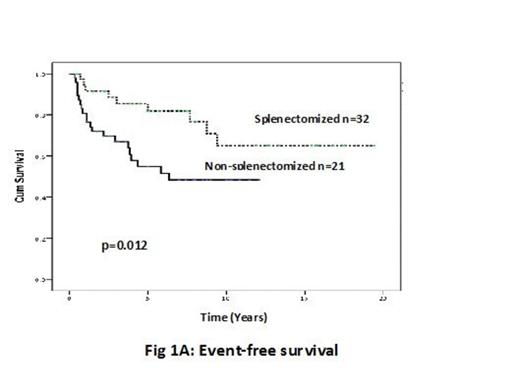Abstract
Introduction: Although the spleen is involved in about a third of patients with non-Hodgkin's lymphoma (NHL), primary splenic diffuse large B-cell lymphoma (PS-DLBCL) is rare having a reported incidence of less than 1% of all NHL. Most of the described series include small numbers of patients before the rituximab era and the role of splenectomy treatment in addition to immuno-chemotherapy is unknown.
Methods: Data were retrospectively collected for 87 patients (pts) with PS-DLBCL treated in 7 medical centers in Israel during the years 1982-2013. Patients presenting with systemic disease with splenic involvement or those having a diagnostic biopsy from other nodal or extranodal disease were excluded.
Results: The mean age was 59.6 years (range, 24-89 years); 57.5% were male. Abdominal pain was reported in 61 pts (81%), B symptoms in 49 pts (59%), ECOG performance status 0 - 1 in 85%. Stage I disease was recorded in 28%, II in 33%, III in 18%, and IV in 21%. Thrombocytopenia (<100,000/µl) was recorded in only 6 pts. Lactic dehydrogenase levels (LDH) were elevated in 69 pts (84%). Favorable International Prognostic Index (IPI) 0-2 was recorded in 62 pts (72%). The mean splenic length was 17.34±6 cm (range 7- 37 cm) and the mean splenic weight was 1216 gm±1243 gm (range 180-6000 gm). A splenic mass was found in 97% of pts, and its mean size was 9.26 cm (range 3-18 cm). The diagnostic procedure was core needle biopsy in 46 pts and splenectomy in 39 pts: 27 underwent open splenectomy and 12 laparoscopic splenectomy. Splenectomized pts had lower IPI (p<0.05) and lower stage (p<0.05) compared to non-splenectomized pts. Treatment: The CHOP regimen was given to 80 pts (92%), DA-EPOCH was given to 2 pts (2%) and 5 pts (6%) received other regimens. Rituximab was given to 68 pts (78%). Complete response was achieved in 67 pts (80%) and partial response in 8 (9%). Relapse occurred in 17 pts (22%).
Survival: The median follow-up time was 7 years (range 0-19.4 years). During this period 24 pts died (27.5%). The 5-year overall survival (OS) was 76.6±4.9% and 5-year event-free survival (EFS) 67.2±5.5%. Splenectomy at diagnosis improved survival: the 5-year EFS was 85.4±6% and 54.7±8% for splenectomized and non-splenectomized pts respectively (p=0.02) and the 5-year OS was 91.2±5% and 67.9±7% respectively (p=0.08). For the 53 pts with stage I-II disease, both 5-year EFS and OS were better in the splenectomized pts (p<0.02, Fig 1). The 5-year EFS and OS in pts with stage I and II disease that were splenectomized at diagnosis was 89.6±6% and 96.4±3.5% as compared with 50.5±11% and 63.2±11% in pts who were not splenectomized (p=0.012 and 0.009). The EFS and OS were not influenced by the stage of the disease. Overall survival was associated with B symptoms (p=0.02), weight loss (p=0.04) and ECOG performance status (p=0.03). In a multivariate model, low ECOG PS and splenectomy independently predicted a better EFS (p=0.03 and 0.02 respectively), however for OS, low ECOG PS independently predicted better OS (p=0.03), while splenectomy had only marginal effect on the OS (p=0.056).
Conclusions: In our group of pts, PS-DLBCL generally presented with abdominal pain, high LDH and a splenic mass. We demonstrate for the first time that splenectomy at diagnosis improves survival in early stages of PS-DLBCL. Our study is a retrospective one. Therefore, until prospective studies prove that early splenectomy in PS-DLBCL is beneficial in terms of overall survival, the risk and benefit of performing splenectomy should be weighed for each patient.
(A) Event-free survival and (B) Overall survival in patients with primary splenic DLBCL and stages I - II disease who did or did not undergo splenectomy at diagnosis.
(A) Event-free survival and (B) Overall survival in patients with primary splenic DLBCL and stages I - II disease who did or did not undergo splenectomy at diagnosis.
No relevant conflicts of interest to declare.
Author notes
Asterisk with author names denotes non-ASH members.



This feature is available to Subscribers Only
Sign In or Create an Account Close Modal